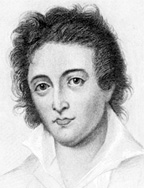
View: Shelley’s Poems
Percy Shelley – Biography
The son of a prosperous squire, he entered Oxford in 1810, where readings in philosophy led him toward a study of the empiricists and the modern skeptics, notably William Godwin. In 1811 he and his friend Thomas Jefferson Hogg published their pamphlet, The Necessity of Atheism, which resulted in their immediate expulsion from the university. The same year Shelley eloped with 16-year-old Harriet Westbrook, by whom he eventually had two children, Ianthe and Charles.
Supported reluctantly by their fathers, the young couple traveled through Great Britain. Shelley’s life continued to be dominated by his desire for social and political reform, and he was constantly publishing pamphlets. His first important poem, Queen Mab, privately printed in 1813, set forth a radical system of curing social ills by advocating the destruction of various established institutions.
In 1814 Shelley left England for France with Mary Godwin, the daughter of William Godwin. During their first year together they were plagued by social ostracism and financial difficulties. However, in 1815 Shelley’s grandfather died and left him an annual income. Laon and Cynthna appeared in 1817 but was withdrawn and reissued the following year as The Revolt of Islam; it is a long poem in Spenserian stanzas that tells of a revolution and illustrates the growth of the human mind aspiring toward perfection.
After Harriet Shelley’s suicide in 1816, Shelley and Mary officially married. In 1817 Harriet’s parents obtained a decree from the lord chancellor stating that Shelley was unfit to have custody of his children. The following year Shelley and Mary left England and settled in Italy. By this time their household consisted of their own three children and Mary’s half-sister Claire Claremont and her daughter Allegra (whose father was Lord Byron). On July 8, 1822, Shelley was drowned while sailing in the Bay of Spezia, near Lerici.
Poetry of Shelley
Shelley was one of the main Romantic Poets, whocombinedpowerful poetic gifts with a questioning ofthe existing social order of the day. He offered an emotive and passionate appeal to the social improvement of society.
“Oh! lift me as a wave, a leaf, a cloud!
I fall upon the thorns of life! I bleed!”
This quote from Ode to the West Wind is symbolic of his style and aspirations and also the sorrows and sufferings of life he frequently encountered.
Further Reading from Amazon.com
